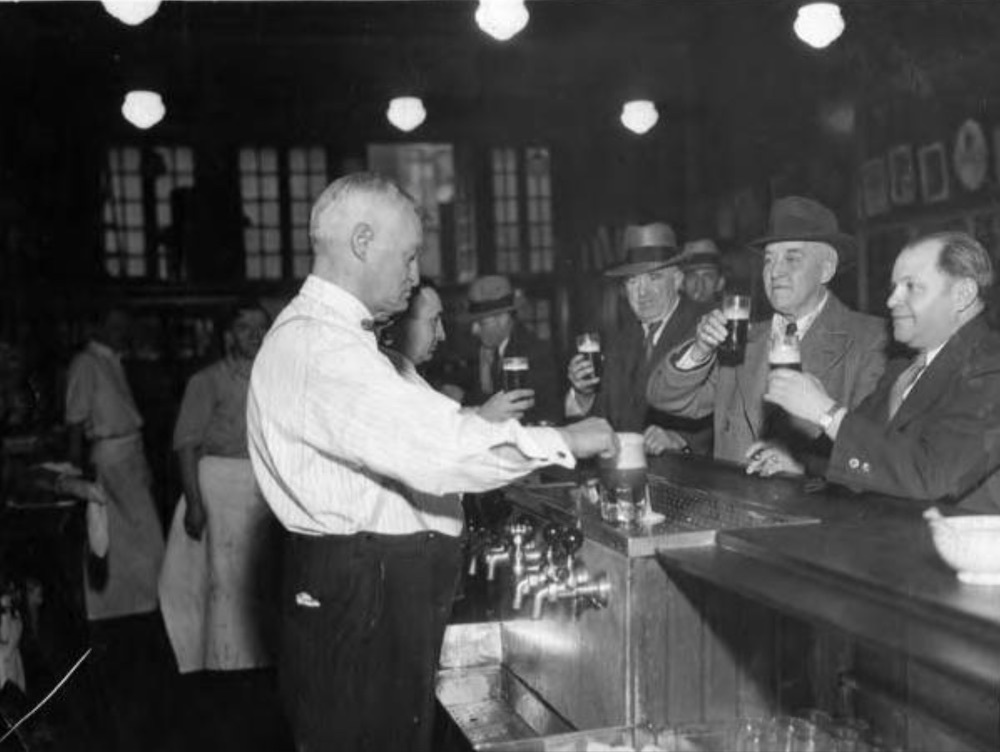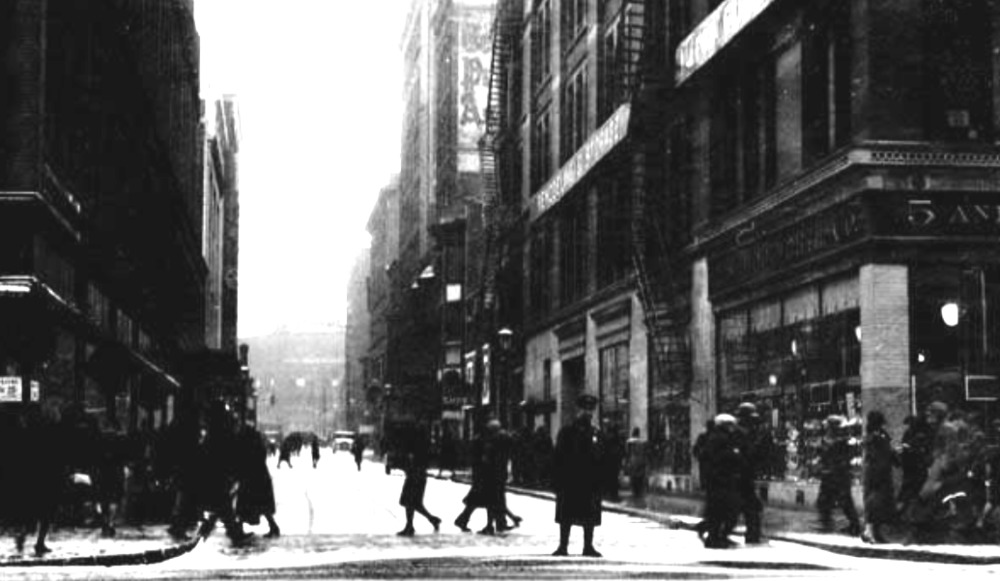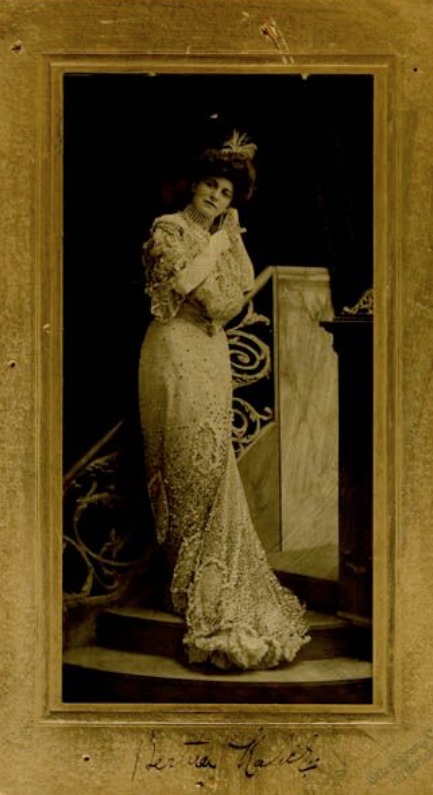
Beginning in 1893, and for nearly 100 years hence, Otto Moser’s was East 4th Street’s hippest hole in the wall—a cramped see-and-be-seen hangout featuring heavy food, boundless booze, and walls dripping with celebrity photos and theatrical playbills.
Otto Moser was a crusty Canton, Ohio, native born in 1865. He came to Cleveland as a boy, lived most of his life on East 73rd Street (known as Otis Avenue until 1906) and launched his famous restaurant before the age of 30. His timing was perfect and his restaurant’s location was ideal: Until the 1920s, the area around East 4th Street (called Sheriff Street until 1906) was the heart of Cleveland's theatrical district, featuring a dozen or more theaters. For nearly 50 years Otto’s restaurant, located in the still extant Krause Building, fed and watered untold thousands of actors, comedians, musicians, acrobats, mimes and impersonators, in addition to show patrons and other downtown denizens. The Krause Building, incidentally, was built by William Krause, who sold and rented theatrical costumes—another example of “right place, right time.”
Otto’s celebrity customers (writers, newspapermen and politicians, as well as performers) achieved photographic immortality by signing and gifting publicity stills that Otto displayed in glass cases and on the restaurant’s walls. Currently under the stewardship of Cleveland State University, Otto’s collection is a theatrical Who’s Who of entertainers that includes Fanny Brice, Helen Hayes, Al Jolson, Sarah Bernhardt, Eddie Cantor, Maurice Evans, Edward Everett Horton, Cornelia Otis Skinner and Paul Muni. Will Rogers once stated that he would “shoot the place full of holes” if he did not see his picture mounted on the wall during his next visit. Plain Dealer writer Marianne Evett visited Otto Moser’s in 1991 and recalled in a subsequent article that “All three Barrymores are there: dashing John surrounded by women; a sleek and gray-haired Lionel; and a very young and vulnerable-looking Ethel staring soulfully from a portrait that might date from her 1902 tour. A youngish W.C. Fields in a scruffy beard wears a tramp costume. George M. Cohan has his autograph scrawled across his forehead. Edwin Booth glowers as Shylock in "The Merchant of Venice." John Philip Sousa gives an austere look from a frame behind the bar.
“And,” Evett continued, “there are others whose fame didn't last. Who was H. Lawson Butt, star of The Garden of Allah in 1913? Young Harry Pilcer, with his carefully parted waves of hair? The Elmore Sisters? Lulu Glaser, who signed her name on December 3, 1901, or Jessie Merrill, who wrote "To the 'boys' with best wishes from the Telephone Girl?”
Although plenty close to (among others) the Hippodrome (1907), Park (1883) and Cleveland (1885) theaters, Otto Moser’s was especially proximate to the esteemed Euclid Avenue Opera House. Built in 1875 on Sheriff Street (a secondary entrance faced Euclid Avenue) the Opera House quickly became Cleveland’s premier showcase for all manner of “legitimate” entertainment—quickly marginalizing the aging Academy of Music on Bank (now West 6th) Street. Owned for a time by Marcus Hanna, the Opera House was largely destroyed in an 1892 fire. However, Hanna rebuilt and the theater reopened on November 11, 1893, quite possibly the same night that Otto Moser’s restaurant came into being directly across Sheriff Street. The Opera House closed and was demolished in 1922 to make way for an S.S. Kresge store. By this time, Cleveland's theatrical epicenter was moving east and “moving pictures” had become entertainment’s biggest draw.
Despite his bistro’s welcoming ambiance, Otto Moser was nonetheless obligated to observe the era’s social and legal canons, and that meant “men only.” But ever the egalitarian opportunist, Otto got around the ban by creating a private “Cheese Club” in the restaurant’s basement. The gathering spot featured a giant wheel of cheese in the middle of the room and served beer to both sexes. The Cheese Club quickly become a destination unto itself, catering to entertainers, politicians, journalists and members of notable families. Theater folk like Lillian Russell, George M. Cohan, Helen Hayes and Eddie Foy put on private shows, told stories, sang songs and recited poetry. A tunnel under Sheriff Street allowed patrons as well as performers to move freely and discretely between the Opera House and the Cheese Club.
By the late 1920s the Opera House was gone and Cleveland’s theater district had moved up Euclid. Yet Otto Moser’s remained unaltered, save for a dry spell during Prohibition. Even after Moser's death in 1942 the restaurant’s character changed little. The establishment was acquired by the Langham family who sold it to Helen Gilman and Moser bartenders Jack and Max Joseph in 1952. The heavy oak furniture stayed. Menu items were still named after celebrities. Food such as house-specialty corned beef and cabbage was still cooked in a downstairs kitchen. Festivities continued to be supervised by a giant plaster eagle with a cigar in its beak and a dusty moose head named Bullwinkle, whose antlers were festooned with customer-donated hats. One big change, however, was (ding!) the establishment’s first cash register: Moser had always thrown paper money into a drawer and piled coins on a marble slab behind the bar.
Dan Bir and Steve Dimotsis were the restaurant’s last owners, purchasing the establishment in 1977 from Nils Osbeck and David Butler, who had purchased it from John Pitt who had purchased it from Max Joseph. Dimotsis moved the restaurant to Playhouse Square in 1994, believing that the area’s renaissance would be better for business. Otto Moser’s continued to entertain performers appearing at Playhouse Square theaters, the Great Lakes Theater Festival and the Cleveland Play House. And naturally, he added more pictures to the walls. The restaurant carried on for another 24 years until it closed for good in 2018. By that time Playhouse Square was rife with after-show dining spots. But not a one displays photos of Dick Thompson “the Burglar” . . . or Haverley’s United Mastodon Minstrels (a 40-man blackface minstrel troupe) . . . or actor Jock McKay sporting kilts and a bagpipe.
Images








